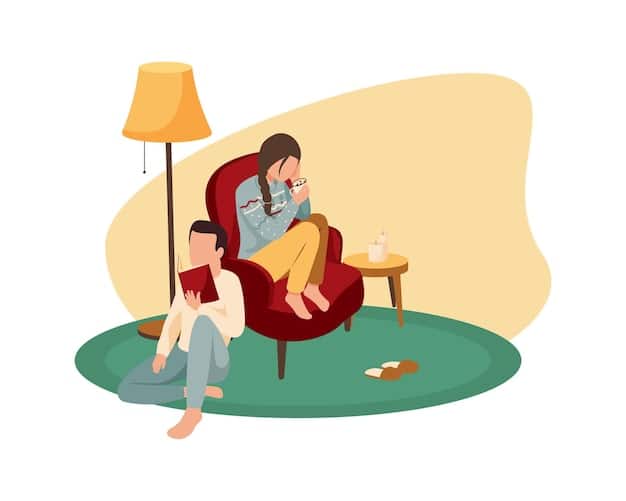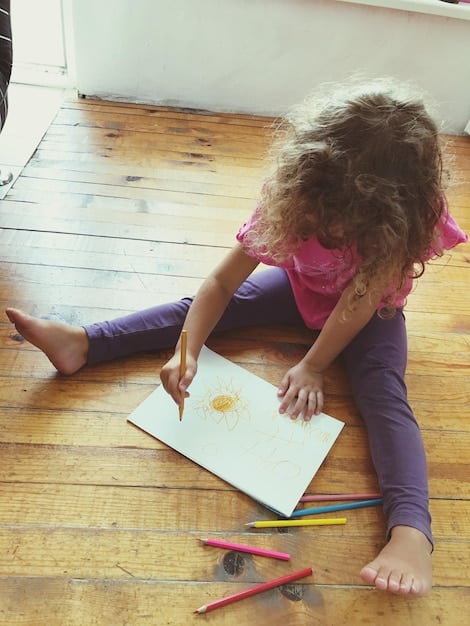Managing Childhood Anxiety: A Parent’s Essential Guide

Childhood anxiety, a prevalent concern across many families, can significantly impact a child’s development and well-being, manifesting in various forms from separation anxiety to social fears; understanding its signs and implementing effective coping strategies are crucial for parents to help their children navigate these emotional challenges and foster resilience.
For many parents, witnessing a child struggle with fear or worry is heartbreaking. When these feelings become persistent, intense, and interfere with daily life, it might be more than just a passing concern – it could be Understanding and Managing Childhood Anxiety: A Parent’s Guide to Helping Your Child Cope. This guide aims to equip parents with the knowledge and tools needed to support their children through these challenging times, fostering resilience and emotional well-being.
Recognizing the Signs: Unmasking Childhood Anxiety
Understanding what childhood anxiety looks like is the first crucial step in helping your child. Anxiety in children doesn’t always present as overt panic attacks; it often manifests in subtle, sometimes disguised, ways that parents might initially miss or misinterpret as behavioral issues. Observing these nuanced cues requires patience and a keen awareness of your child’s typical demeanor and routine deviations.
Common Behavioral Manifestations
Anxiety can cause children to act out, become defiant, or withdraw. These behaviors are often misinterpreted as misbehavior, when in reality, they are a cry for help as the child struggles to articulate their internal distress. It’s essential to differentiate between typical childhood phases and persistent patterns. When anxiety becomes a consistent disruptor in their everyday life, it’s time to pay closer attention to its underlying causes.
- Frequent meltdowns or temper tantrums, especially when facing new situations or social events.
- Avoidance of specific activities, places, or people that previously brought joy or were routine.
- Excessive clinginess or difficulty separating from parents/caregivers, even in familiar environments.
- Increased irritability or outbursts when faced with minor stressors or unexpected changes.
Physical Symptoms and Emotional Cues
Children often lack the vocabulary to express complex emotions, so their bodies become the primary channel for communication. Physical complaints without an apparent medical cause can be a strong indicator of underlying anxiety. Moreover, heightened emotional sensitivity or an inability to calm down after a perceived threat are important emotional signals. Addressing these physical and emotional cues directly can pave the way for understanding their anxiety.
Headaches, stomach aches, and fatigue are common somatic complaints linked to chronic stress and anxiety in children. These physical symptoms are very real to the child and should not be dismissed as imaginary. Persistent sleep disturbances, such as difficulty falling asleep or frequent nightmares, are also strong indicators that a child might be experiencing elevated levels of anxiety. Their minds continue to race even when their bodies are tired, preventing restful sleep.
Additionally, pay attention to changes in appetite, nail-biting, hair-twisting, or repetitive behaviors that emerge during stressful periods. These are often self-soothing mechanisms that children employ to manage overwhelming feelings. Noticing these shifts can provide valuable insight into their internal state.
Recognizing the diverse presentation of anxiety in children is paramount. It involves careful observation, active listening, and a willingness to look beyond surface-level behaviors to the deeper emotional and physical signals your child is sending. Early identification can significantly impact the effectiveness of intervention strategies.
Understanding the Root Causes of Childhood Anxiety
Understanding the underlying factors contributing to a child’s anxiety is crucial for effective management. Anxiety is rarely a standalone issue; it often stems from a complex interplay of genetic, environmental, and developmental influences. Pinpointing these potential causes can help parents tailor their approach and seek targeted support.
Genetic and Biological Predispositions
Research suggests that a predisposition to anxiety can be inherited. Children with a family history of anxiety disorders or depression may have a higher likelihood of developing similar issues. This doesn’t mean it’s inevitable, but it does highlight the importance of early intervention and creating a supportive environment. Biological factors, such as imbalances in brain neurotransmitters, can also play a role in how a child processes emotions and stress.
While genetics may load the gun, environment pulls the trigger. Even with a genetic predisposition, a nurturing and stable environment can significantly mitigate the risk. It’s about understanding the cards you’re dealt and how to play them effectively. A child’s inherent temperament, such as being naturally shy or highly sensitive, can also make them more susceptible to anxiety, particularly in unfamiliar or overstimulating situations.
Environmental and Experiential Factors
A child’s home environment, school experiences, and significant life events profoundly influence their emotional development. Stressful family dynamics, such as parental conflict or financial hardship, can create an atmosphere of uncertainty that fuels anxiety. Similarly, traumatic events, even those seemingly minor to an adult, can deeply impact a child.
- Sudden changes, such as moving homes or schools, which disrupt routines and introduce uncertainty.
- Exposure to prolonged stress or conflict within the family, leading to a sense of instability.
- Academic pressure or social difficulties at school, including bullying or feeling isolated.
- Experiencing or witnessing traumatic events, even if indirectly, which can trigger lasting fear responses.
Parenting Styles and Attachment
The way parents interact with their children can either foster resilience or unintentionally exacerbate anxious tendencies. Overprotective parenting, while well-intentioned, can prevent children from developing essential coping skills by shielding them from mild stressors. Conversely, inconsistent or dismissive parenting might leave children feeling insecure and anxious about their safety and emotional needs.
A secure attachment with primary caregivers provides a vital foundation for emotional security. When this attachment is disrupted or insecure, children may develop anxiety as a coping mechanism for perceived instability. Parents who model anxious behaviors may also inadvertently teach their children to react similarly to stress. Leading by example, therefore, is a powerful tool in shaping a child’s emotional responses.
A comprehensive understanding of these varied causes allows parents to approach their child’s anxiety with empathy and informed strategies. It moves beyond simple observation to a deeper appreciation of the complex factors shaping their child’s emotional world, paving the way for more effective support and long-term well-being.
Effective Communication: Talking to Your Anxious Child
Open and supportive communication is a cornerstone of managing childhood anxiety. Children need to feel heard and understood, especially when they are struggling with overwhelming emotions. Approaching these conversations with empathy and patience can make a significant difference in helping your child process their feelings.
Creating a Safe Space for Expression
The first step is to establish an environment where your child feels safe to share their worries without judgment. This means listening actively, validating their feelings, and avoiding immediate solutions or dismissals. Let them know that all feelings are okay, even the uncomfortable ones. Choose a quiet time when both of you are relaxed, perhaps during a bedtime story or a leisurely walk.
It’s crucial to acknowledge their feelings without trying to “fix” them right away. Phrases like “I see you’re feeling scared about school, and that’s a tough feeling” can be incredibly validating. This helps your child feel understood and less alone in their struggles. Avoid minimizing their fears with statements like “There’s nothing to worry about” or “Just get over it,” as this can undermine their trust and make them less likely to open up in the future.
Using Age-Appropriate Language and Tools
Children’s understanding of emotions and ability to articulate them varies significantly with age. Tailoring your communication style to your child’s developmental stage is vital. Younger children might benefit from metaphors or drawing, while older children may prefer direct conversations. Use simple, concrete terms rather than abstract psychological jargon.

- For younger children, use puppets or storybooks to explore emotions indirectly.
- Encourage drawing or playing as a way for them to express feelings they can’t verbalize.
- For older children, ask open-ended questions like “What helps you feel calm?” or “What’s the hardest part about this for you?”
- Introduce emotion-feeling charts or mood thermometers to help them identify and label their emotions.
Teaching Coping Language and Affirmations
Beyond simply listening, empower your child with words and phrases that help them verbalize their anxiety and advocate for themselves. Teach them to say, “I’m feeling worried right now” instead of acting out, or “I need a moment” when they feel overwhelmed. Positive affirmations can also be powerful tools.
Help your child develop a “worry vocabulary” that gives them control over their internal experience. Practices like guided breathing exercises, where they might imagine blowing out candles or smelling a flower, can be verbally integrated into their daily routine. Affirmations such as “I am brave” or “I can handle this” repeated regularly can help rewire anxious thought patterns.
Consistent, empathetic communication builds a strong foundation of trust and understanding. It allows your child to see you as a safe harbor, a place where their anxieties can be shared and explored without fear. This collaborative approach is essential for equipping them with the skills they need to navigate their emotional landscape independently.
Practical Strategies for Parents: Building Resilience
Empowering your child to cope with anxiety involves equipping them with practical strategies that build resilience over time. These aren’t quick fixes but rather consistent practices that, when integrated into daily life, can significantly reduce the impact of anxious feelings and help children develop healthy emotional regulation skills.
Teaching Relaxation and Mindfulness Techniques
One of the most effective ways to combat anxiety is to teach children techniques to calm their bodies and minds. Simple breathing exercises, like “belly breathing” or counting breaths, can be powerful tools. Mindfulness, the practice of focusing on the present moment, can help children observe their thoughts without being consumed by them.
Introduce these techniques during calm times, not just when anxiety strikes, so they become familiar and accessible. Guided meditations tailored for children, often available through apps or online resources, can also be a gentle way to introduce mindfulness. Regular practice, even for a few minutes each day, can strengthen their ability to self-regulate and respond to stress more effectively.
Encouraging Gradual Exposure and Problem-Solving
Helping children face their fears, rather than avoid them, is a critical component of overcoming anxiety. This should always be done gradually and supportively, providing just enough challenge to stretch their comfort zone without overwhelming them. The process is often referred to as “brave steps.”
- Break down intimidating situations into smaller, manageable steps, celebrating each small victory.
- Role-play scenarios that trigger anxiety, allowing your child to practice responses in a safe environment.
- Engage in collaborative problem-solving, asking “What can we do to make this a little less scary?” rather than dictating solutions.
- Encourage them to identify their own coping strategies and evaluate what works best for them in different situations.
Fostering a Sense of Control and Competence
Anxiety often thrives on a feeling of helplessness. By providing opportunities for your child to make choices, take on age-appropriate responsibilities, and experience success, you can build their sense of control and competence. This empowerment helps counteract the feeling that external events dictate their emotional state.

Involve your child in decisions whenever possible, from choosing their clothes to planning a family outing. Celebrate effort and perseverance, not just outcomes, to reinforce a growth mindset. Help them identify and leverage their strengths, reminding them of past successes when they doubt their abilities. These experiences build self-efficacy, a belief in one’s capacity to succeed, which is a powerful buffer against anxiety.
Implementing these practical strategies requires consistency and patience. There will be setbacks, but each small step forward celebrates progress and reinforces the idea that anxiety is manageable. By actively teaching and modeling these skills, parents can empower their children to become resilient and capable individuals.
The Role of Lifestyle: Diet, Sleep, and Exercise
A holistic approach to managing childhood anxiety must include attention to basic lifestyle factors. Diet, sleep, and physical activity are not just general health recommendations; they are foundational pillars that significantly impact a child’s mental and emotional well-being. Neglecting these areas can exacerbate anxious tendencies, while optimizing them can provide a powerful buffer against stress.
Nutrition and Gut-Brain Connection
What a child eats directly affects their brain chemistry and mood. Processed foods, excessive sugar, and artificial additives can contribute to mood swings, irritability, and heightened anxiety. Conversely, a balanced diet rich in whole foods supports stable blood sugar levels and promotes healthy neurotransmitter function.
The gut-brain axis is a rapidly evolving area of research, showing a strong connection between gut health and mental well-being. A diet high in fruits, vegetables, whole grains, and lean proteins, coupled with adequate hydration, feeds a healthy gut microbiome, which in turn supports brain health and emotional regulation. Consider reducing caffeine intake, even from sodas, as it can mimic and worsen anxiety symptoms in sensitive children.
Adequate and Restful Sleep
Sleep deprivation can dramatically amplify anxiety symptoms in children. A lack of quality sleep impairs emotional regulation, attention, and problem-solving skills, making it harder for children to cope with daily stressors. Establishing a consistent, calming bedtime routine is paramount.
- Ensure a consistent bedtime and wake-up time, even on weekends, to regulate the child’s internal clock.
- Create a dark, quiet, and cool sleep environment free from electronic devices for at least an hour before bed.
- Incorporate relaxing activities into the bedtime routine, such as a warm bath, reading a book, or gentle stretching.
- Address any underlying sleep disturbances, such as sleep apnea or insomnia, with a healthcare professional.
Physical Activity and Play
Regular physical activity is a natural stress reliever and mood enhancer. Exercise helps burn off excess energy that can contribute to restlessness and anxiety, while also releasing endorphins that have a calming effect. Play, particularly unstructured outdoor play, is equally vital for emotional development.
Encourage children to engage in activities they enjoy, whether it’s organized sports, running around in the park, dancing, or riding a bike. The goal is to make movement a fun and integrated part of their day, not a chore. Outdoor play also provides exposure to natural light and fresh air, both of which are beneficial for mood regulation and sleep cycles. Play allows children to process emotions, practice social skills, and release tension in a healthy, natural way.
By prioritizing these lifestyle components, parents actively contribute to their child’s overall well-being, creating a strong physiological foundation that bolsters their ability to manage anxiety. These aren’t supplemental additions but rather essential ingredients for a mentally healthy and resilient child.
Understanding When to Seek Professional Help
While parental support and lifestyle adjustments are incredibly powerful, there are times when childhood anxiety requires the expertise of a mental health professional. Recognizing these indicators and knowing when to seek external help is a sign of strength and commitment to your child’s well-being. Delaying professional intervention can prolong suffering and potentially lead to more entrenched patterns of anxiety.
Signs That Professional Help Is Needed
It can be challenging to distinguish between typical childhood worries and anxiety that warrants professional attention. A key indicator is the persistence and intensity of the anxiety, and how much it significantly impacts various aspects of your child’s life. When daily functioning is impaired, it’s a clear signal.
Consider seeking professional help if your child’s anxiety has lasted for several weeks or months, despite your best efforts to support them. If their worries become increasingly severe, irrational, or unmanageable for them, it’s time to consult an expert. Sometimes, anxiety presents itself as extreme sensitivity or an inability to adapt to normal life transitions, making even minor changes feel catastrophic.
- The anxiety is severe, persistent, and interferes significantly with daily life (school, friendships, family activities).
- Your child frequently avoids social situations, school, or other activities they once enjoyed due to fear.
- They experience recurrent panic attacks or intense physical symptoms of anxiety (e.g., shortness of breath, dizziness, chest pain) without a clear medical cause.
- You notice regressive behaviors, such as bedwetting or thumb-sucking, that have returned due to stress.
- Existing coping strategies are no longer effective, and the child’s distress seems to be escalating.
- The anxiety is accompanied by other concerning symptoms like depression, self-harm ideation, or extreme irritability.
Types of Professionals and Therapies
When seeking professional help, it’s important to understand the different types of specialists and therapeutic approaches available. Pediatricians can provide initial guidance and referrals, while mental health professionals offer specialized diagnostic and treatment services. The goal is to find a therapist who is a good fit for your child and family.
Child psychologists, psychiatrists, and licensed clinical social workers are trained to diagnose and treat childhood anxiety. Cognitive-Behavioral Therapy (CBT) is often considered the gold standard for anxiety disorders in children. It helps children identify and challenge anxious thoughts and gradually face fears. Exposure and Response Prevention (ERP), a specific type of CBT, is particularly effective for obsessive-compulsive themes.
Family therapy can also be beneficial, as anxiety often affects the entire family system. It helps parents learn strategies to support their child and improve family communication around anxiety. In some cases, medication might be considered as an adjunct to therapy, particularly for severe anxiety or when co-occurring conditions are present. This decision should always be made in consultation with a child psychiatrist or pediatrician specializing in mental health.
Remember, seeking professional help is not a sign of failure, but rather an active and loving step towards ensuring your child receives the best possible care. Early intervention can prevent anxiety from becoming a chronic issue, allowing your child to thrive and develop healthy coping mechanisms for life.
Building a Supportive Environment at Home and School
Creating a consistent and nurturing environment, both at home and in school, is fundamental for children managing anxiety. These settings represent the primary ecosystems in which children grow and develop, and ensuring they feel safe, predictable, and supportive can significantly reduce their anxious responses. Collaboration between parents and educators is key to this holistic approach.
Establishing Routine and Predictability at Home
Children thrive on predictability. A consistent daily routine provides a sense of security and reduces the uncertainty that often fuels anxiety. When children know what to expect, they are better able to mentally prepare for transitions and new activities, minimizing unexpected stressors.
This includes consistent routines for meals, homework, playtime, and bedtime. Visual schedules can be especially helpful for younger children or those who struggle with transitions. Clearly communicating any changes in advance and involving your child in the planning can also help them feel more in control. A calm and organized home environment reduces overall stress levels for both parents and children.
Collaborating with School and Educators
School can be a significant source of anxiety for many children. Open communication with teachers, school counselors, and administrators is vital to ensure your child receives appropriate support. Sharing insights about your child’s anxiety and discussing specific triggers can help educators implement effective strategies within the classroom.
- Schedule regular meetings with teachers to discuss your child’s progress and any concerns regarding their anxiety.
- Share strategies that work well at home, such as specific calming techniques or ways your child expresses distress.
- Explore accommodations, if necessary, such as preferential seating, extra time for tests, or a designated “safe space” in the classroom.
- Advocate for your child if they are experiencing social challenges or bullying, which can significantly heighten school-related anxiety.
Modeling Healthy Coping and Self-Care
Children learn by observing. Your own response to stress and anxiety provides a powerful model for your child. Demonstrating healthy coping mechanisms, practicing self-care, and acknowledging your own feelings (in an age-appropriate way) teaches them invaluable lessons about emotional regulation.
While shielding children from all stress is impossible, allowing them to see you navigate challenges with resilience and grace is incredibly empowering. This means openly talking about your feelings, engaging in your own stress-reducing activities, and prioritizing your well-being. When parents attend to their own mental health, they are better equipped to support their children, creating a ripple effect of well-being throughout the family unit.
A supportive environment is not about eliminating all challenges; it’s about equipping children with the tools and safety net to face them. By fostering predictability, promoting collaboration, and modeling healthy behaviors, parents can create a sanctuary where their children can grow, learn, and manage their anxiety with increasing confidence.
Long-Term Outlook: Fostering Lifelong Resilience
**Understanding and Managing Childhood Anxiety: A Parent’s Guide to Helping Your Child Cope** is not just about immediate relief; it’s about laying the groundwork for lifelong resilience. The strategies and support provided during childhood can profoundly influence a child’s ability to navigate future stressors and thrive emotionally. This long-term perspective emphasizes growth, adaptation, and consistent care.
Empowering Independence and Problem-Solving Skills
The ultimate goal is to equip children with the inner resources to manage their own anxiety. This involves gradually fostering independence, allowing them to participate in decision-making, and supporting their efforts to solve problems themselves. Overprotection, while well-intentioned, can inadvertently hinder this developmental process.
As children grow older, encourage them to identify their triggers, understand their coping strategies, and articulate their needs. Guide them through problem-solving processes rather than solving everything for them. This creates a sense of agency and competence, assuring them that they possess the inner strength to confront life’s difficulties.
Normalizing Emotions and Reducing Stigma
Anxiety, like any emotion, is a normal part of the human experience. Helping children understand that it’s okay to feel anxious, and that these feelings will pass, is crucial. Normalizing these emotions reduces shame and encourages open dialogue, counteracting the stigma often associated with mental health challenges.
Discuss anxiety openly and without judgment. Share your own experiences, where appropriate, to show them they are not alone. Emphasize that seeking help, whether from a parent, a friend, or a professional, is a sign of strength. By fostering an environment where emotions are acknowledged and processed, children learn to integrate their anxious feelings rather than suppress or fear them.
Continuous Learning and Adaptation
A child’s developmental journey is constantly evolving, and so too will their expressions of anxiety and their coping needs. What works today might need adjustment tomorrow. Parents must remain flexible learners, continually observing their child, adapting strategies, and seeking new information as their child grows.
Stay informed about childhood development and mental health resources. Be open to revisiting professional support if new challenges arise or existing strategies become less effective. Resilience is not about avoiding problems, but about the capacity to recover from them. By consistently nurturing their child’s emotional growth and providing a steadfast source of support, parents can ensure their child develops the lifelong skills needed to face challenges with confidence and composure.
Ultimately, supporting a child with anxiety is a journey of unwavering love, patience, and commitment. It’s about teaching them that while anxiety may be a part of their story, it does not define their future. With the right tools and unwavering support, children can grow into resilient individuals, capable of navigating life’s ups and downs with strength and grace.
| Key Aspect | Brief Description |
|---|---|
| 🔍 Recognizing Signs | Observe behavioral changes, physical complaints, and emotional cues carefully to identify anxiety. |
| 🗣️ Effective Communication | Create a safe space, validate feelings, and use age-appropriate language to encourage sharing. |
| 🛠️ Practical Strategies | Teach relaxation, gradual exposure, and foster a sense of competence through problem-solving. |
| ❤️ Seeking Professional Help | Know when to consult experts like child psychologists for specialized diagnosis and therapy. |
Frequently Asked Questions About Childhood Anxiety
Normal worries are usually temporary, related to specific events (like a test), and don’t significantly interfere with daily life. Anxiety disorders are characterized by persistent, intense, and often irrational fears that impact school, friendships, or family activities. If worries are disruptive for several weeks, it’s worth observing more closely.
Common types include separation anxiety, specific phobias (e.g., fear of dogs), social anxiety, generalized anxiety disorder (GAD), and panic disorder. Each has distinct symptoms, but they all involve excessive fear or worry and often physical symptoms like stomachaches or headaches. Early identification is key for effective management.
Create a safe, non-judgmental space. Avoid asking direct “why” questions immediately. Instead, use open-ended statements like “I notice you seem worried” or “I’m here to listen whenever you’re ready.” Engaging in shared activities like drawing while talking can also make it easier for them to open up.
Absolutely. “Belly breathing” (placing a hand on their stomach to feel it rise and fall) and “balloon breathing” (imagining their belly as a balloon inflating and deflating) are excellent. The “five-finger breathing” technique, tracing each finger while inhaling and exhaling, also provides a simple, visual aid for mindful breathing.
Medication is typically considered after other interventions, like therapy (especially CBT), have been explored or when anxiety is severe and debilitating. This decision should always be made in close consultation with a child psychiatrist or pediatrician specializing in mental health, carefully weighing benefits and potential side effects.
Conclusion
Navigating childhood anxiety is a complex journey, but one that parents can effectively manage with knowledge, patience, and a well-rounded approach. By understanding the varied signs of anxiety, both subtle and overt, delving into potential root causes, and fostering open communication, parents lay a powerful foundation for their child’s emotional well-being. Implementing practical strategies such as relaxation techniques and gradual exposure, alongside prioritizing healthy lifestyle components like diet, sleep, and exercise, significantly bolsters a child’s resilience. Crucially, recognizing when to seek professional help and fostering a supportive home and school environment ensures that children receive targeted interventions when needed. Ultimately, the goal is to empower children with the tools and confidence to navigate their anxieties, not just in the present, but throughout their lives, cultivating a strong sense of self-efficacy and emotional wisdom to thrive.





